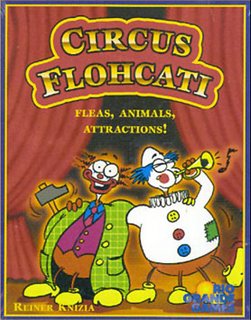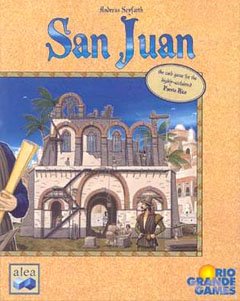 In my introductory column I said this column would cover boardgames and custom card games that don't use the standard 52-card deck. It's taken nine columns, but I'm finally getting to card games. There are as many interesting and unique designer card games being created as board games. So where to start?
In my introductory column I said this column would cover boardgames and custom card games that don't use the standard 52-card deck. It's taken nine columns, but I'm finally getting to card games. There are as many interesting and unique designer card games being created as board games. So where to start?Let's start with Circus Flohcati because it is a game that works well for very young children through adults. It also says it plays up to five but I've played it with six players many times. The name is a combination of English and German and is about a flea circus. If you don't know what a flea circus is, ask your parents or grandparents if necessary, you won't believe the answer.
With Circus Flohcati there are ten suits in different colors numbered 0 to 7, illustrated with ten different names and types of flea circus acts. The first player flips over the top card and takes it if they want. If not, another card is flipped. As long as the suit of the new card is not the same as a card showing, it may be taken by the player or added to the display. Players continue to flip over cards until they take one, or until a card of a suit that is showing is flipped in which case that card is discarded and that player's turn ends with them getting no card.
The game ends when someone has collected one card from each suit. That player gets a bonus, but everyone adds up the face value of his or her cards. There are three action cards. Two that let you steal a card from another player and one that allows the player to keep rolling cards until they get a match, discard it and still draw a card.
This is a great game for kids and adults. It generally runs ten to fifteen minutes and has lots of replay value. Circus Flohcati is by Reiner Knizia and published by Rio Grande Games.
 San Juan is a card game version of boardgame called Puerto Rico, but works very well on its own whether you have played Puerto Rico or not. This is an innovative game of city building and economics. The cards represent buildings, which are worth victory points and have additional functions. Some cards produce goods, which can be sold for more cards, while others have unique abilities that aid that player.
San Juan is a card game version of boardgame called Puerto Rico, but works very well on its own whether you have played Puerto Rico or not. This is an innovative game of city building and economics. The cards represent buildings, which are worth victory points and have additional functions. Some cards produce goods, which can be sold for more cards, while others have unique abilities that aid that player.There are five "role" cards (not like in D&D, don't be scared). Each player selects a role such as builder. That player, as the builder, gets a one-card discount on the cost of playing a new building card face up. The other players will also be able to build at the regular price. If a card costs five to build, a player will place that card face up and discard five cards from their hand as payment. Other roles include the chance to use their production buildings to produce, and then later sell that product or draw a new card. Players are constantly trying to acquire more cards so they can build more buildings.
The particular abilities of the buildings are important and getting buildings in combinations where the abilities compliment each other, say a building that increases production and another that allows players to trade an extra good, is the key to success. The game is a race to build twelve buildings but all players will add up the value of their buildings to determine a winner. The game usually lasts 20-30 minutes and works well for two, three and four players. San Juan is by Andreas Seyfarth and is published by Rio Grande Games.
 Finally I'll mention another fast and fun card game called No Thanks!. It is a very simple and is fast but has a bit of bite to it. There's a deck of cards numbered 3 to 35. Each player gets eleven chips. The deck is shuffled and nine cards are randomly removed from the game without looking at them. A card is flipped. If a player wants it they take it. If not, they pay a chip. When someone takes a card they get it and all the chips players have paid to avoid it. Chips are worth a point and cards are worth minus the face value in points. However, if you get consecutive numbers, only the smallest numbered card is counted against the player. The fun in the game is making others pay you to take a card that you want, but they can't really afford to take. The game always unfolds nicely, accommodates 3-5 and takes maybe 10 minutes to play. No Thanks! is by Thorsten Gimmler and is published by Z-Man Games.
Finally I'll mention another fast and fun card game called No Thanks!. It is a very simple and is fast but has a bit of bite to it. There's a deck of cards numbered 3 to 35. Each player gets eleven chips. The deck is shuffled and nine cards are randomly removed from the game without looking at them. A card is flipped. If a player wants it they take it. If not, they pay a chip. When someone takes a card they get it and all the chips players have paid to avoid it. Chips are worth a point and cards are worth minus the face value in points. However, if you get consecutive numbers, only the smallest numbered card is counted against the player. The fun in the game is making others pay you to take a card that you want, but they can't really afford to take. The game always unfolds nicely, accommodates 3-5 and takes maybe 10 minutes to play. No Thanks! is by Thorsten Gimmler and is published by Z-Man Games.These games should be available locally at a specialty game shop. Even if the shop doesn't have the game in stock, many are happy to special-order them. Your local store is a great place to learn more about these great games. Online, I'd suggest going to Google, click on Froogle and search for the game by name. I promise I won't wait another nine weeks to talk about card games again.
Ward Batty is a long-time game-player who has been with the same weekly game group for over twenty years. "I understood there was a pension." is his excuse. He writes a monthly column on the business of board games for Comics & Game Retailer magazine and has written articles and reviews for The Games Journal, Scrye, Knucklebones and Games International.
The Game Table is a weekly column which is self-syndicated by the author. If you would like to see this column in your local newspaper, please write the managing editor of the paper. Interested in carrying The Game Table in your paper, please contact Ward Batty.
